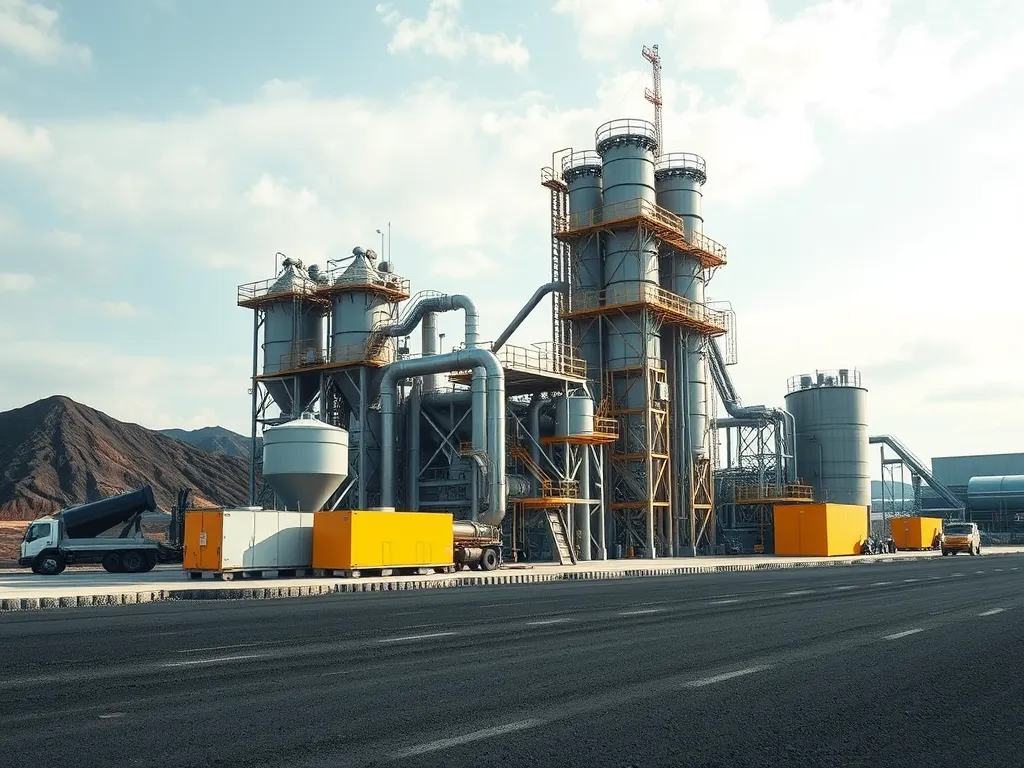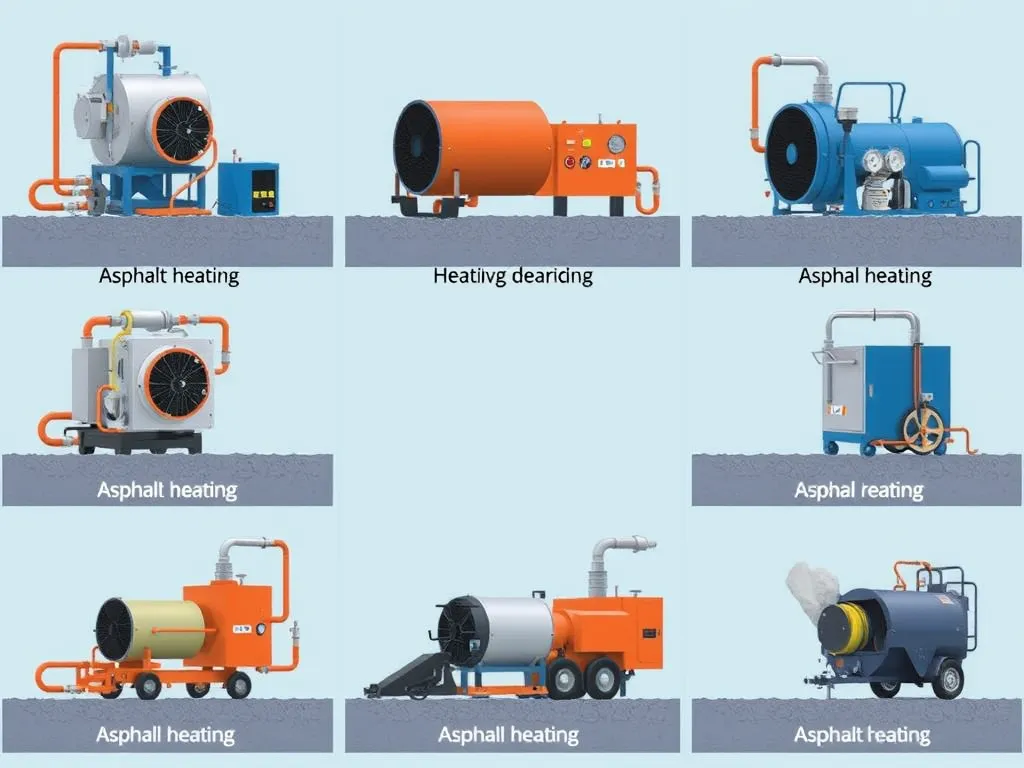Bitumen in Highway Construction: Applications & Asphalt Integration
Published on: September 19, 2025 | Last Updated: April 14, 2025
Written By: George Voss
Bitumen serves as the primary binding agent in asphalt mixes for highway construction, combining crushed stone and sand to create durable road surfaces. This petroleum-based material provides flexibility across temperature extremes (from -20°F to 150°F), waterproofing through its 95% impermeability rate, and adhesion strength through PG (Performance Graded) binders. Its dominance over tar and concrete stems from lower costs ($45-$80 per ton versus $120-$150 for concrete), faster curing times, and 100% recyclability in asphalt reuse programs.
This article breaks down bitumen’s highway applications from material science to real-world paving. You’ll learn how polymer-modified bitumen handles heavy truck traffic, why cold mix techniques work for rural roads, and how layer thickness standards vary for interstates versus local routes. We’ll compare installation methods like hot mix asphalt production and sprayed seal coats, analyze cost factors per lane-mile, and review environmental innovations like warm-mix asphalt reducing emissions by 30%.
Contents
- Understanding Bitumen in Highway Construction
- Types Of Bitumen for Asphalt Highway Construction
- Critical Properties Of Bitumen for Highway Asphalt
- Bitumen Application Process in Highway Construction
- Structural Composition Of Bitumen Highway Roads
- Advantages Of Bitumen in Asphalt Highway Systems
- Cost Analysis Of Bitumen in Highway Projects
- Environmental Considerations for Bitumen Roads
- Case Studies: Bitumen in Major Highway Projects
- FAQs: Bitumen in Highway Construction
- Closing Thoughts
- Useful References for You:
Understanding Bitumen in Highway Construction
Bitumen forms the backbone of modern highway systems. This sticky hydrocarbon binder transforms loose aggregates into cohesive pavement layers capable of handling heavy traffic. Let’s break down its role, properties, and key distinctions from similar materials.
What is Bitumen in Road Construction?
Bitumen is a semi-solid petroleum product derived from crude oil distillation. In highway projects, it acts as the glue binding crushed stone, sand, and gravel into asphalt concrete. With 60-70% penetration grades common for roads, it adapts to seasonal temperature shifts while maintaining structural cohesion. Refineries produce approximately 100 million tons annually for global infrastructure needs.
Primary Purpose Of Bitumen in Asphalt Highway Development
Bitumen serves three critical functions in asphalt highways:
- Binding aggregates into a load-bearing matrix
- Waterproofing pavement layers against moisture damage
- Providing flexibility to handle thermal expansion/contraction
Modern mixes use PG (Performance-Graded) binders rated for specific climates. PG 64-22, for example, performs in regions with pavement temps from -20°F to 150°F.
Bitumen Vs. Tar: Why Bitumen is Preferred for Roads
Though both act as binders, bitumen outperforms tar in highway applications:
| Bitumen | Tar |
|---|---|
| Petroleum-based | Coal-derived |
| Higher temperature stability | Softens above 140°F |
| Lower toxicity | Releases carcinogenic fumes |
Bitumen’s lower temperature sensitivity reduces rutting in summer while preventing winter cracking.
Bitumen Vs. Asphalt: Clarifying Terminology
These terms are often confused:
- Bitumen: The black viscous binder (5-8% of asphalt mix)
- Asphalt: Composite material containing 92-95% aggregates + 5-8% bitumen
In highway specs, “asphalt concrete” refers to the finished pavement layer, while bitumen denotes the binding agent. Superpave mix designs optimize their interaction for specific traffic loads and climates.
With bitumen’s core functions established, let’s examine the specific formulations driving modern highway projects. [Segue to next section] Now that we’ve clarified bitumen’s role, the next section explores specialized types like PMB and cutback bitumen used in different construction scenarios.
Types Of Bitumen for Asphalt Highway Construction
Bitumen selection shapes road performance. Four primary variants dominate highway projects. Each serves distinct roles based on climate, traffic, and structural needs.
Penetration Grade Bitumen
Penetration grade (PG) bitumen ranks as the most common binder for highways. Named after its hardness measured by a needle test at 77°F, grades like PG 64-22 or 70-10 determine load capacity. PG 64-22 handles moderate climates with 64°C high-temp resistance and -22°C low-temp flexibility. Used in 85% of US highways, this grade balances durability with cost at $500-$700 per ton.
Polymer-modified Bitumen (PMB)
PMB adds polymers like styrene-butadiene-styrene (SBS) to base bitumen. This upgrade boosts crack resistance by 60% and extends pavement life to 20+ years. High-stress zones—bus lanes, airport runways, or mountain passes—rely on PMB. While costing 30-50% more than standard grades, it reduces rutting in areas with 10,000+ daily trucks.
Cutback Bitumen and Emulsions
Cutback bitumen mixes solvents like kerosene for cold-weather paving. Emulsions blend bitumen with water and surfactants, enabling workability below 50°F. Both options suit rural roads or patching. Emulsions cure faster (2-4 hours vs. 24+ for cutbacks) and emit 40% fewer VOCs. States like Alaska use emulsions for 90% of seasonal repairs.
Oxidized Bitumen for Specialized Applications
Oxidized bitumen undergoes air-blowing to harden for extreme conditions. With penetration values of 15-40 mm/10, it withstands chemical spills or bridge deck expansion joints. Though pricier ($900-$1,200/ton), its 90+ ductility rating prevents cracks in heavy industrial zones or coastal highways exposed to saltwater.
Choosing the right bitumen type sets the stage for evaluating performance. Next, we examine key properties that dictate how these binders hold highways together.

Critical Properties Of Bitumen for Highway Asphalt
Bitumen’s performance in highway construction depends on specific material traits that meet road engineering demands. These properties ensure asphalt pavements handle traffic, weather, and time.
Durability Under Traffic Loads
Bitumen resists deformation from heavy trucks and high-volume traffic. Its elastic recovery (measured via ductility tests above 100 cm at 25°C) prevents permanent ruts in asphalt layers. Penetration grades like 60/70 or 80/100 balance stiffness and flexibility – critical for highways carrying over 10,000 vehicles daily. Modified bitumen with SBS polymers boosts fatigue resistance by 300%, extending pavement life beyond 15 years.
Temperature Resistance in Pavement Layers
Bitumen must stay stable across temperature extremes. Performance Graded (PG) binders like PG 76-22 withstand road surface temps from -22°C to 76°C. In hot climates, polymer-modified mixes prevent softening at 60°C+ asphalt temps. Cold regions rely on low-temperature PG grades to avoid thermal cracking below -34°C. Thermal susceptibility tests ensure viscosity stays between 150-450 Poise during mixing at 160°C.
Adhesion With Aggregates in Asphalt Mixes
Bitumen’s ability to coat and bind aggregates determines pavement strength. The rolling bottle test measures adhesion retention – quality mixes retain 95% coating after water immersion. Poor adhesion causes stripping, leading to potholes. Lime or amine additives improve bonding in wet conditions. Aggregate absorption rates below 2% prevent bitumen film thickness drop below 8 microns – a key factor in mix design.
Water Resistance and Asphalt Longevity
Bitumen’s hydrophobic nature blocks water infiltration – the top cause of pavement failure. Marshall stability tests show water-soaked samples retain 80-90% strength with proper bitumen content. Dense-graded mixes using 4-6% bitumen by weight achieve 3-5% air voids, minimizing moisture damage. Emulsified bitumen seals micro-cracks, reducing water penetration by 70% compared to untreated surfaces.
These material traits set the stage for effective application methods. Next, we examine how engineers translate bitumen properties into durable pavement during construction.
Also See: Future Innovations in Asphalt Testing Procedures
Bitumen Application Process in Highway Construction
Proper techniques ensure bitumen performs optimally across highway surfaces. From rural routes to high-traffic interstates, each method adapts to project needs while maximizing pavement life.
Surface Preparation for Asphalt Paving
Milling machines remove old asphalt layers, creating a clean base for new pavement. Workers apply tack coats—thin bitumen layers—to boost adhesion between existing surfaces and fresh asphalt. Crack sealing precedes this step, using PG 64-22 bitumen to fill gaps up to 1 inch wide. Proper grading ensures water drains at 2% slope minimum, critical for bitumen road longevity.
Hot Mix Asphalt Production With Bitumen
Batch plants heat aggregates to 150-175°C before mixing with 5-7% bitumen by weight. Polymer-modified bitumen (PMB) enhances high-temperature stability in mixes like Superpave, designed for 20+ million ESALs (Equivalent Single Axle Loads). Trucks transport HMA at 135-150°C to prevent premature cooling. Density targets hit 92-96% during compaction for highway-grade durability.
Cold Mix Techniques for Rural Highway Projects
Emulsified bitumen binds aggregates without heating, ideal for remote areas. Slow-setting CMS-2 emulsions allow 72-hour workability for patching or low-volume roads. Additives like hydrated lime improve moisture resistance. Cold mix costs drop 30-40% versus HMA, with 15-year service life in light traffic zones.
Sprayed Seal Coats Using Bitumen Emulsions
Bitumen emulsions CSS-1 or RS-2 spray at 0.5-1.2 gal/yd², followed by crushed aggregates (3/8” size). This seals cracks, prevents water ingress, and restores skid resistance. Single-coat systems last 5-7 years, while double-layered seals extend service to 10 years. Emulsions cure faster than cutbacks, reducing road closure times by 50%.
Mastering these methods ensures highways withstand traffic and weather. Next, we examine how layered pavement systems leverage bitumen’s strengths.

Structural Composition Of Bitumen Highway Roads
Bitumen highway systems rely on multi-layer designs to bear traffic while resisting deformation. Each stratum serves distinct functions, working together to create roads lasting 15-20 years under heavy use.
Subgrade and Base Layer Preparation
Road construction begins with compacting the subgrade to 95% Proctor density. Engineers test soil bearing capacity using CBR values, targeting ≥8% for high-volume routes. Over this, crews install crushed stone base layers ranging from 6-12 inches thick. Common materials include Class 2 Aggregate Base meeting gradation specs of 1.5” to fines. Properly built bases prevent rutting by distributing loads before reaching the subgrade.
Bituminous Binder Course Construction
This intermediate layer binds the base to the surface course. Mix designs use PG 64-22 bitumen with 3/4” aggregates, heated to 300°F during paving. Binder courses typically run 2-4 inches thick, providing structural rigidity. Contractors monitor density levels, compacting to 92-96% of theoretical maximum to minimize voids. The course cures for 24 hours before surface layer installation.
Asphalt Wearing Course Installation
The top 1.5-3 inches endure direct traffic impact. Polymer-modified bitumen (PMB) mixes dominate here, blending 5-7% PMB content with 3/8” aggregates. Paving crews maintain mix temperatures above 280°F for optimal workability. Steel-wheel rollers achieve 98% compaction, creating smooth surfaces with skid resistance ≥45 BPN. Open-graded mixes reduce hydroplaning risks by permitting 18-22% air voids for drainage.
Layer Thickness Standards by Road Classification
- Interstates: 12” base + 4” binder + 3” surface (19” total)
- Arterials: 8” base + 3” binder + 2” surface (13” total)
- Local Roads: 6” base + 2” binder + 1.5” surface (9.5” total)
State DOTs adjust specs based on ESALs (Equivalent Single Axle Loads). For example, roads handling >10 million ESALs over 20 years require 15% thicker binder courses.
These structural benchmarks directly influence lifecycle costs—setting the stage for evaluating bitumen’s economic benefits in modern infrastructure.
Advantages Of Bitumen in Asphalt Highway Systems
Bitumen asphalt highway builds stand out for practicality and function. This material’s mix of traits allows road networks to adapt to changing needs while keeping budgets in check.
Cost-effectiveness Vs. Concrete Alternatives
Bitumen road construction cuts costs by 30-50% upfront compared to concrete. A typical asphalt highway lane-mile runs $2.5M, while concrete hits $4M+. Savings grow with PMB (polymer-modified bitumen) mixes lasting 15-20 years with minimal upkeep. Lifecycle costs drop further as 95% of asphalt gets reused during resurfacing. This makes highway bitumen roads a go-to for agencies managing tight funds.
Rapid Construction and Repair Capabilities
Hot mix asphalt with bitumen hits full strength in 24 hours, allowing traffic fast. Concrete needs 7-28 days to cure. Pothole fixes take minutes with cold mix bitumen, not days. Such speed limits road closure impacts—critical for urban zones where delays cost $250K+ hourly. Night crews can repave a highway section by dawn, avoiding rush hour snarls.
Noise Reduction in Urban Highway Design
Bitumen asphalt highway surfaces cut traffic noise 3-5 dB versus concrete—a 50% drop in loudness. Open-graded mixes with high air voids (18-22%) absorb tire sounds. Cities like Phoenix use porous asphalt overlays near housing, trimming noise complaints by 70%. This trait aids compliance with FHWA noise mandates without costly sound walls.
Bitumen’s role in road builds spans budgets, timelines, and livability. Up next: breaking down how these savings add up over a highway’s lifespan.

Cost Analysis Of Bitumen in Highway Projects
Bitumen’s role in highway construction costs balances initial investments against decades of service life. With asphalt-bitumen mixes forming 25-35% of total pavement costs, project planners weigh material choices against traffic demands and climate factors.
Price Variables for Asphalt-bitumen Mixes
Crude oil prices directly sway bitumen costs, with 2023 averages hitting $450-$650 per metric ton. Mix designs using polymer-modified bitumen (PMB) add 30-50% to material expenses but boost rut resistance. Rural projects often opt for cutback bitumen at $3.50-$4.20 per gallon, saving 15% versus hot-mix alternatives. Transportation adds $15-$25 per ton for sites beyond 150 miles from refineries.
Long-term Maintenance Cost Considerations
Bitumen’s flexibility cuts crack formation rates by 60% versus rigid pavements, slashing resealing needs. A Federal Highway Administration study found bitumen highways require $12,000-$18,000 per lane-mile in annual upkeep – 40% less than concrete. Recycled asphalt pavement (RAP) mixes with fresh bitumen trim material costs by 25-40% during resurfacing cycles. Properly designed bitumen roads last 20-25 years before full-depth reconstruction.
These cost dynamics position bitumen asphalt highways as fiscally sustainable options. Up next: How environmental innovations are reshaping bitumen’s role in modern infrastructure.
Environmental Considerations for Bitumen Roads
Bitumen highway construction balances performance with ecological impact. Modern methods prioritize material reuse and cleaner production to meet sustainability goals.
Recyclability Of Asphalt Pavement Materials
Bitumen asphalt highways achieve 95% recyclability through reclaimed asphalt pavement (RAP) systems. RAP combines milled old pavement with fresh bitumen and aggregates, reducing virgin material use by 20-30%. Federal Highway Administration data shows 82 million tons of RAP reused annually in U.S. road projects.
Cold recycling techniques process RAP at ambient temperatures, cutting energy use by 40% compared to hot mix plants. Agencies like Caltrans now mandate 15-35% RAP in bitumen road construction mixes, maintaining pavement strength while lowering costs by $3-$7 per ton.
Emissions Management During Hot Mix Production
Traditional hot mix asphalt plants operating at 300-350°F generate 18-22 lbs of CO₂ per ton of mix. New technologies slash emissions:
| Technology | Temperature Reduction | Emission Cut |
|---|---|---|
| Warm Mix Additives | 50-100°F | 35% CO₂ |
| Electric Plant Heaters | N/A | 90% Particulates |
| Bio-Binders | N/A | 15% VOCs |
Foamed bitumen techniques inject cold water into heated binder, creating micro-bubbles that improve coating at lower temps. Plants using these methods meet EPA Tier 4 standards while producing 350 tons/hour of highway-grade asphalt.
Innovations in bitumen highway development now focus on lifecycle analysis – from production through decades of service. Next, we examine how these materials perform in actual megaprojects.

Case Studies: Bitumen in Major Highway Projects
Real-world projects prove bitumen’s value in modern highway systems. From bustling urban corridors to remote climate-challenged routes, these examples show how binder selection directly impacts pavement performance.
High-capacity Motorway Construction Examples
Germany’s Autobahn network relies on polymer-modified bitumen (PMB) mixes to handle 150,000+ vehicles daily. The PG 76-22 binder used resists deformation under heavy truck traffic while maintaining flexibility. In the U.S., Interstate 35 in Texas utilized 12% recycled asphalt pavement (RAP) with PG 64-22 bitumen, cutting material costs by $85,000 per lane-mile during its 2022 expansion.
Bitumen Performance in Extreme Climate Roads
Canada’s Trans-Canada Highway employs PMB blended with styrene-butadiene-styrene (SBS) to withstand -40°C winters. The modified binder prevents thermal cracking better than standard penetration-grade products. Saudi Arabia’s Highway 40 uses rubberized bitumen containing 18% crumb rubber, reducing rutting by 60% in 50°C summer heat compared to conventional mixes.
These projects demonstrate how tailored bitumen solutions meet specific engineering demands. Up next: Common questions about binder selection and pavement performance answered.
FAQs: Bitumen in Highway Construction
How Does Bitumen Improve Asphalt Flexibility?
Bitumen enhances the flexibility of asphalt by providing a viscous binder that allows the mixture to expand and contract with temperature changes. This flexibility reduces the risk of cracking and ensures the pavement can withstand the stresses of heavy traffic and varying weather conditions.
What Determines Bitumen Quantity Per Kilometer?
The quantity of bitumen used per kilometer of highway is determined by several factors, including the type of road, traffic volume, climate conditions, and the specific design requirements of the asphalt mix. Generally, it is calculated based on the total weight of the asphalt mixture, which typically contains 5-8% bitumen by weight. Factor adjustments may be made for specialized applications or varying pavement thicknesses.
What Are Environmental Impacts Of Bitumen in Highway Construction?
The environmental impacts of using bitumen in highway construction include concerns about emissions during production, as well as the resource-intensive nature of petroleum extraction. However, advancements in recycling asphalt and using warm mix technologies have significantly reduced these impacts. Furthermore, bitumen’s high recyclability supports sustainable practices by minimizing waste.
How is Bitumen Tested for Quality Assurance?
Quality assurance tests for bitumen typically include viscosity assessments, penetration tests, and ductility measurements. These tests verify that the bitumen meets the required specifications for temperature resistance, adhesion, and durability under traffic loads. Performance-graded (PG) testing also evaluates the bitumen’s behavior across different temperatures and stresses.
Can Bitumen Be Used in Cold Weather Conditions?
Yes, bitumen can be designed for cold weather applications through the use of emulsified or cutback bitumen. These formulations allow for effective paving operations even at lower temperatures, ensuring that road construction can continue without significant delays due to seasonal changes.
What Role Does Bitumen Play in Recycling Asphalt Pavements?
Bitumen is a key component in recycled asphalt pavements (RAP), where milled asphalt is combined with fresh bitumen to produce new asphalt mixtures. This process not only conserves resources by reusing existing materials but also reduces costs and lowers the environmental impact of new road construction.
Closing Thoughts
Bitumen plays a pivotal role in highway construction by enhancing the performance and longevity of asphalt pavements. Its properties, such as durability, temperature resistance, and water resistance, make it an ideal choice for modern roads.
The application process, from surface preparation to the construction of various asphalt layers, showcases the versatility of bitumen. Options like Polymer-Modified Bitumen (PMB) and emulsions provide tailored solutions for specific project needs, delivering cost-effectiveness compared to concrete alternatives.
Moreover, the recyclability of asphalt materials supports sustainable practices in construction. As more highways integrate bitumen in their design, they embrace not only efficiency but also environmental responsibility.
For more information on asphalt and bitumen in highway construction, check out Asphalt Calculator USA.
Useful References for You:
- Transportation Research Board (TRB, Peer-Reviewed Research & Circulars)
- Uses of Bitumen in Road Construction: Types and Benefits
- Bitumen Road Construction: Materials, Design, Construction Techniques | Fluidconstructions
- Engineering bitumen for future asphalt pavements: A review of chemistry, structure and rheology – ScienceDirect
- Bitumen – Wikipedia


